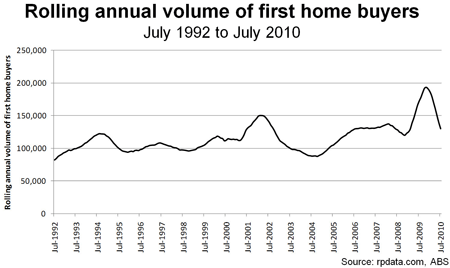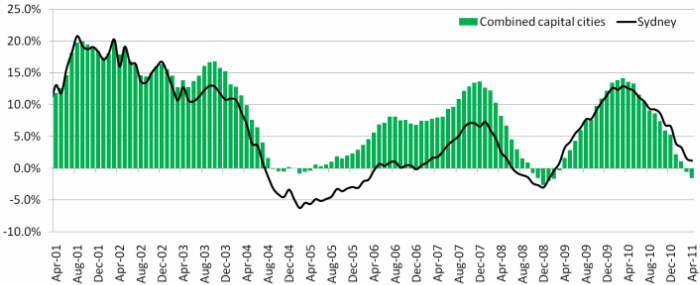
Will they never learn?
Nearly 11 years on since it was first introduced the federal grant for first home owners still stands at $7000, even though the average house price has more than doubled in that time. That’s led one leading mortgage broker to suggest it is time the scheme was upgraded.
The residential housing market had changed significantly since 2000 and the $7000 grant was no longer adequate, Loan Market said.
“The economics that drove the original payment are outdated and need to be reviewed as per any government grant,” said the broker’s chief operating officer Dean Rushton on Wednesday.
The First Home Owners Grant (FHOG) was introduced by the Howard government to help offset the impact of the GST on home ownership.
“For the FHOG to continue to help buyers, it needs to reflect the conditions they face in 2011, not 2000,” Mr Rushton said.
Most recent Australian Bureau of Statistics (ABS) data shows the size of an average home loan taken out by a first-time buyers was $285,400. Back in June 2000 it was just $137,400.
Mr Rushton said the $7000 grant had been effectively halved.
Ok.. I can’t go on. Mr Rushton is asking for the government to once again increase the first home buyers grant.
I know I am repeating myself here but let’s go through it again. Last time the government increased the first home buyers grant it created a surge of new credit, that pushed up sales volumes, leading to higher prices.
It is now well understood what the effects of this policy were, and there is now good evidence that the economy is paying the price for those days of policy folly. None of this led to better outcomes for first home buyers. A quick glance at any capital city housing market , even one that is still showing some growth such as Sydney, clearly displays this trend from late 2008 onwards.
Mr Rushton’s request for more new government stimulus money is about as transparent as a brick wall, but seems quite typical of a vested interest who hasn’t quite woken up to the “new” Australian economy.
He doesn’t seem to have realised that his business is not one that has a place in the RBA’s new economy. The RBA are now looking to slowly lower the level of private sector debt using the rising level of capital from the resource sector as a economic stabiliser. I have previous referred to this as “steering godzilla’s see-saw with a mallet“.
Tuesday’s speech by Glenn Stevens re-affirmed this message.
… Of course it is easy to talk about structural change in the abstract. It is another thing to cope with it in practice. There are no magic-pill solutions, nor are there any real alternatives to adjustment. What solutions there are, though, are likely to involve a re-focusing on productivity performance after a period in which, at least at a national level, our productivity growth has been disappointing.
As the Unconventional Economist noted last night, Glenn hasn’t quite managed to take any responsibility for the country’s current economic position, but his and other members of the RBA’s latest speeches make it quite clear what the plan now is. My interpretation of the problem and their solution is as follows.
“We wasted the last decade borrowing too much money in order to consume beyond our means, this cannot continue. The good luck of the world’s appetite for our resources gives us an opportunity to address this by using the incoming capital to slowly pay down that debt and re-adjust our economy back to what we should have been doing in the first place, that is concentrating on productivity. This adjustment will be slow and painful ( for some ) but we have little choice. The RBA isn’t about to admit it was part of the problem, but it doesn’t care if you don’t like the solution. If you are adversely effected by the transition then suck it up, you shouldn’t have put so much on the credit card in the first place.”
Of course Mr Rushton is directing his comments at the Treasurer, but again, we can refer to Captain Glenn to put that to bed:
Fiscal policy is also playing a significant role. The ‘fiscal impact’, calculated as the shift in the Federal budget position from one year to the next, is forecast to be minus 2 per cent of GDP in the 2011/12 fiscal year. A further, though slightly smaller, effect is forecast by the Treasury in the following year.
I hope that makes it clear enough to Mr Rushton that his call for more credit driven growth will fall on deaf ears.
Until the next crisis.

